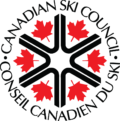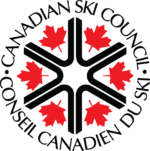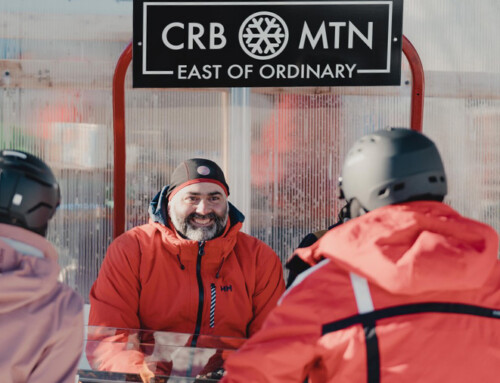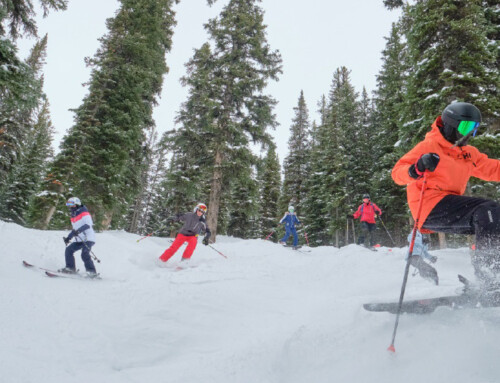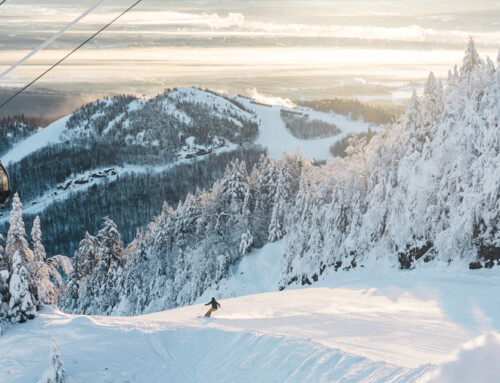Have you ever seen a dog riding a chairlift? How about a dog skiing next to its owner? Or even crazier, a dog being long-lined under a helicopter? These are just a few of the skills that make avalanche dogs… Super canines!
Meet Mogul, a four-year-old German Shepherd who adores his ball and will do anything for fresh veggies. When Mogul isn’t falling asleep with a ball in his mouth or receiving never-ending attention, he also works as a Canadian Avalanche Rescue Dog AND a Search and Rescue Dog. This means Mogul has a job all year round, making sure his handler, as well as anyone venturing into the backcountry, can play safe. So what exactly does it take to become an avalanche dog? To answer that question we caught up with Megan Kelly, Assistant Ski Patrol Director for us here at FAR, and companion to the amazing, Mogul.
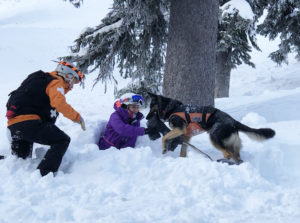
Preparation for the Canadian Avalanche Rescue Dog Association (CARDA) certification begins when a puppy is just six months old. It starts with simple obedience training such as following commands, playing tug-of-war, and getting the dog to chase objects or people. It gradually progresses to the handler hiding and having the dog come find them. Eventually, they progress to open snow caves, where someone can hide, awaiting discovery. The snow caves go from being open to having closed off walls. The last step in the progression is using articles, usually, pieces of wool fabric saturated with human scent, buried under the snow. The dog eventually learns that in a real avalanche situation it is very unlikely they’ll have clues, so they need to rely on the scent of a human rising from under the snow to help find them. Finally, the dog is able to be given a command, like “search”, and will have the control to do their work and search for a missing person. The final test to complete certification requires the dog to search for 40 minutes, looking for two articles buried 75 centimetres under the snow to mimic a live person. CARDA certification takes a year and a half to complete and requires dogs to be tested every year in order to keep up their certification. Handlers are also tested every second year to make sure their skills are still up to date.
So what can an avalanche dog achieve that aids in a successful rescue? Simply put, it would take a search and rescue team up to four hours or more to search one hectare of terrain. It takes an avalanche dog just thirty minutes to achieve the same results. With avalanche dogs being so quick, agile, and possessing a highly sensitive nose, they use their training to identify human scents and track it right to the source.
Fun fact time! Did you know that Fernie has the privilege of the first live rescue done by an avalanche dog in Canada? That’s right! In the early 2000s, Robin Siggers and his avalanche pup Keno recovered someone who had been caught in an avalanche in the backcountry without a transceiver. It was this circumstance as well as inspiration from other handlers in town that caught Megan’s attention. In describing why she decided to become an avalanche dog handler Megan said, “I was inspired by that working relationship, you know the fact that you can bring the dog to work. There’s also a chance you can really make a difference in someone’s life or you can save a life, I just wanted to contribute to that, and it’s a good way to volunteer.” Megan and Mogul are part of the 40 other volunteer search and rescue members in the valley and are on call 24 hours a day. There are two other full-time avalanche dog and handler teams, as well as a few part-time teams, who not only serve Fernie and area but can also be called provincially to aid in rescues.
But don’t think it’s all work and no play! According to Megan, Mogul is a best friend who receives all the best treatment. “Mogul really loves just being at the top of the lift at Bear top and just hanging out and saying hi to everyone. When he retires he’d like to be a Public Relations dog.” When the working vest is off, Mogul loves to bask in the attention of the public, but when the vest is on he’s much like a celebrity who has learned to ignore the praise of their adoring fans. No paparazzi, please!
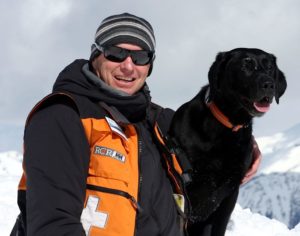
Steve Morrison, who is a member of the ski patrol team at FAR and handler to avalanche dog Neko, cautions the general public to be aware that avalanche dogs are working dogs. “…We want people to be friendly, but just at the right time. After I take his vest off is a good time, because otherwise, that’s the cue that the dog is working. I’m usually fine with people approaching the dog, as long as they ask me and maybe remove their skis or snowboard first…”
Speaking of meeting our super avalanche dogs, we are happy to be offering two demos to show off their stuff on February 23rd! Avalanche Awareness Day is coming your way, and it should come as no surprise that we’ve got plenty of fun and educational activities planned in the plaza and on the mountain. From 11 am to 2 pm we’ll have an Avalanche Awareness Information tent set up in the plaza. Don’t miss your opportunity to meet and watch our avalanche dogs in action, happening at 11 am AND 2 pm at the base of the Deer Chair. And finally, join us for an après fundraising auction in the Griz Bar, the proceeds of which go to Avalanche Canada to support their educational initiatives.
So why should you take the time to become more avalanche aware? According to Megan, the backcountry invites you to learn and discover. “The backcountry has given me so much in my life. I’ve learnt so much about myself, I’ve connected with nature, I’ve developed these cool skills by going into avalanche terrain in the winter. But I’ve done that by being avalanche aware and keeping myself safe, having the right gear and knowing how to use it. That’s opened up this whole world for me, which is why I encourage people to go ahead and become avalanche aware, so you don’t have to avoid that terrain if you don’t want to. You can engage in it and learn something about yourself.”
So whether you are shredding it up with us at Fernie Alpine Resort, or having an adventure in the backcountry, be aware and most importantly… Stay safe and play safe!
Feature photo of Mogul by Abby Cooper
